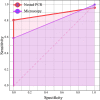PET-PCR reveals low parasitaemia and submicroscopic malarial infections in Honduran Moskitia
- PMID: 36978056
- PMCID: PMC10053754
- DOI: 10.1186/s12936-023-04538-x
PET-PCR reveals low parasitaemia and submicroscopic malarial infections in Honduran Moskitia
Abstract
Background: Malaria remains a main parasitic disease of humans. Although the largest number of cases is reported in the African region, there are still endemic foci in the Americas. Central America reported 36,000 malaria cases in 2020, which represents 5.5% of cases in the Americas and 0.015% of cases globally. Most malaria infections in Central America are reported in La Moskitia, shared by Honduras and Nicaragua. In the Honduran Moskitia, less than 800 cases were registered in 2020, considering it an area of low endemicity. In low endemicity settings, the number of submicroscopic and asymptomatic infections tends to increase, leaving many cases undetected and untreated. These reservoirs challenge national malaria elimination programmes. This study aimed to assess the diagnostic performance of Light Microscopy (LM), a nested PCR test and a photoinduced electron transfer polymerase chain reaction (PET-PCR) in a population of febrile patients from La Moskitia.
Methods: A total of 309 febrile participants were recruited using a passive surveillance approach at the Puerto Lempira hospital. Blood samples were analysed by LM, nested PCR, and PET-PCR. Diagnostic performance including sensitivity, specificity, negative and positive predictive values, kappa index, accuracy, and ROC analysis was evaluated. The parasitaemia of the positive samples was quantified by both LM and PET-PCR.
Results: The overall prevalence of malaria was 19.1% by LM, 27.8% by nPCR, and 31.1% by PET-PCR. The sensitivity of LM was 67.4% compared to nPCR, and the sensitivity of LM and nPCR was 59.6% and 80.8%, respectively, compared to PET-PCR. LM showed a kappa index of 0.67, with a moderate level of agreement. Forty positive cases by PET-PCR were not detected by LM.
Conclusions: This study demonstrated that LM is unable to detect parasitaemia at low levels and that there is a high degree of submicroscopic infections in the Honduran Moskitia.
Keywords: Honduras; Nested PCR; PET-PCR; Parasitaemia; Plasmodium species; Submicroscopic malaria.
© 2023. The Author(s).
Conflict of interest statement
Some authors of this manuscript are military service members and employees of the U.S. Government. This work was prepared as part of their official duties. Title 17 U.S.C. §105 provides that copyright protection under this title is not available for any work of the United States Government. Title 17 U.S.C. §101 defines a U.S. Government work as work prepared by a military service member or employee of the U.S. Government as part of that person’s official duties. The views expressed in this article are those of the authors and do not necessarily reflect the official policy or position of the Department of the Navy, Department of Defense, nor the U.S. Government.
Figures




Similar articles
-
High-resolution melting analysis reveals low Plasmodium parasitaemia infections among microscopically negative febrile patients in western Kenya.Malar J. 2014 Nov 15;13:429. doi: 10.1186/1475-2875-13-429. Malar J. 2014. PMID: 25399409 Free PMC article.
-
Performance evaluation of RDT, light microscopy, and PET-PCR for detecting Plasmodium falciparum malaria infections in the 2018 Zambia National Malaria Indicator Survey.Malar J. 2021 Sep 28;20(1):386. doi: 10.1186/s12936-021-03917-6. Malar J. 2021. PMID: 34583692 Free PMC article.
-
Diagnostic accuracy of loop-mediated isothermal amplification (LAMP) for screening malaria in peripheral and placental blood samples from pregnant women in Colombia.Malar J. 2018 Jul 13;17(1):262. doi: 10.1186/s12936-018-2403-5. Malar J. 2018. PMID: 30005616 Free PMC article.
-
Global patterns of submicroscopic Plasmodium falciparum malaria infection: insights from a systematic review and meta-analysis of population surveys.Lancet Microbe. 2021 Aug;2(8):e366-e374. doi: 10.1016/S2666-5247(21)00055-0. Lancet Microbe. 2021. PMID: 34382027 Free PMC article.
-
Systematic review of the diagnostic accuracy of thick smear compared to polymerase chain reaction for pregnancy-associated malaria, 2010-2022.Rev Peru Med Exp Salud Publica. 2022 Jul-Sep;39(3):302-311. doi: 10.17843/rpmesp.2022.393.11739. Epub 2022 Dec 5. Rev Peru Med Exp Salud Publica. 2022. PMID: 36478163 Free PMC article.
Cited by
-
Genetic diversity of Plasmodium vivax and Plasmodium falciparum field isolates from Honduras in the malaria elimination phase.Curr Res Parasitol Vector Borne Dis. 2024 Nov 21;7:100230. doi: 10.1016/j.crpvbd.2024.100230. eCollection 2025. Curr Res Parasitol Vector Borne Dis. 2024. PMID: 39759387 Free PMC article.
-
Asymptomatic Malaria Reservoirs in Honduras: A Challenge for Elimination.Pathogens. 2024 Jun 27;13(7):541. doi: 10.3390/pathogens13070541. Pathogens. 2024. PMID: 39057768 Free PMC article.
References
-
- Chaves-Carballo E, Samuel T. Darling: studies on malaria and the Panama Canal. Bull Hist Med. 1980;54:95–100. - PubMed
-
- WHO . World Malaria Report 2021. Geneva: World Health Organization; 2022.
MeSH terms
Grants and funding
LinkOut - more resources
Full Text Sources
Medical

